Related Research Articles
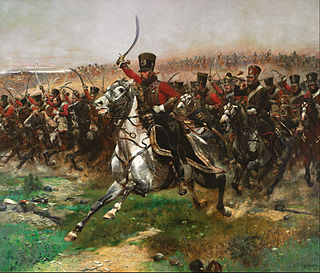
Historically, cavalry are groups of soldiers or warriors who fight mounted on horseback. Until the 20th century, cavalry were the most mobile of the combat arms, operating as light cavalry in the roles of reconnaissance, screening, and skirmishing, or as heavy cavalry for decisive economy of force and shock attacks. An individual soldier in the cavalry is known by a number of designations depending on era and tactics, such as a cavalryman, horseman, trooper, cataphract, knight, drabant, hussar, uhlan, mamluk, cuirassier, lancer, dragoon, samurai or horse archer. The designation of cavalry was not usually given to any military forces that used other animals or platforms for mounts, such as chariots, camels or elephants. Infantry who moved on horseback, but dismounted to fight on foot, were known in the early 17th to the early 18th century as dragoons, a class of mounted infantry which in most armies later evolved into standard cavalry while retaining their historic designation.

Dragoons were originally a class of mounted infantry, who used horses for mobility, but dismounted to fight on foot. From the early 17th century onward, dragoons were increasingly also employed as conventional cavalry and trained for combat with swords and firearms from horseback. While their use goes back to the late 16th century, dragoon regiments were established in most European armies during the 17th and early 18th centuries; they provided greater mobility than regular infantry but were far less expensive than cavalry.

The Royal Scots Greys was a cavalry regiment of the Army of Scotland that became a regiment of the British Army in 1707 upon the Union of Scotland and England, continuing until 1971 when they amalgamated with the 3rd Carabiniers to form the Royal Scots Dragoon Guards.
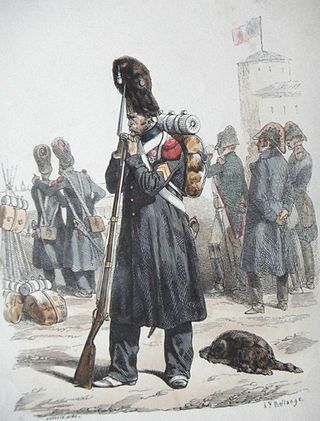
The Imperial Guard was an elite guard formation of the French Imperial Army under the direct command of Napoleon. Expanding considerably over time, the formation acted as his bodyguard and tactical reserve, and he was careful of its use in battle. The Imperial Guard was divided into a general staff and infantry, cavalry and artillery regiments as well as battalions of sappers and marines. It distinguished between experienced veterans and less experienced members by being separated into three sections: the Old Guard, Middle Guard and Young Guard. The Young Guard was virtually annihilated in the Battle of Krasnoi during the French invasion of Russia.
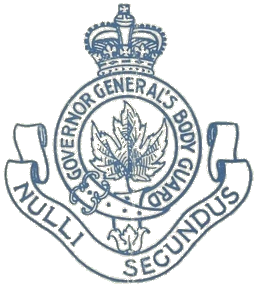
The Governor General's Body Guard was a royal guard regiment of the Canadian Army that formed part of the country's household troops. The Body Guard was the senior regiment of the Canadian Army and the equivalent of the British Army's Life Guards and Royal Horse Guards. In 1936 the regiment amalgamated with the Mississauga Horse to become The Governor General's Horse Guards.

A carabinier is in principle a soldier armed with a carbine, musket, or rifle, which became commonplace by the beginning of the Napoleonic Wars in Europe. The word is derived from the identical French word carabinier.
Mounted infantry were infantry who rode horses instead of marching. Unlike cavalry, mounted infantry dismounted to fight on foot. The original dragoons were essentially mounted infantry. According to the Encyclopædia Britannica Eleventh Edition (1910-1911), "Mounted rifles are half cavalry, mounted infantry merely specially mobile infantry." Today, with motor vehicles having replaced horses for military transport, the motorized infantry are in some respects successors to mounted infantry.

The 4th Princess Louise Dragoon Guards is an inactive armoured regiment of the Canadian Militia / Canadian Army. It is currently on the Supplementary Order of Battle.

The United States Cavalry, or U.S. Cavalry, was the designation of the mounted force of the United States Army. The United States Cavalry was formally created by an act of Congress on 3 August 1861 and ceased as a distinct Army branch in 1942. The name "cavalry" continues to be used as a designation for various specific United States Army formations and functions.

The Austro-Hungarian Army, also known as the Imperial and Royal Army, was the principal ground force of Austria-Hungary from 1867 to 1918. It consisted of three organisations: the Common Army, the Imperial-Royal Landwehr and the Royal Hungarian Honvéd.
The Light Division is a light infantry division of the British Army. It was reformed in 2022, as part of Future Soldier reforms.
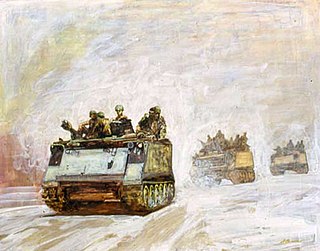
Armoured cavalry are military units using armoured fighting vehicles (AFVs) instead of horses. They began to replace horse cavalry in the heavy shock and the light reconnaissance, skirmishing and exploitation/pursuit roles in most armies commencing after the First World War. In that succeeding capacity, the obsolete name "cavalry" was retained.
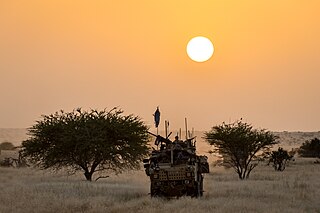
There are 13 cavalry regiments of the British Army each with its own unique cap badge, regimental traditions, and history. Of the currently nine regular cavalry regiments, two serve as armoured regiments, three as armoured cavalry regiments, three as light cavalry, and one as a mounted ceremonial regiment. There are also four yeomanry regiments of the Army Reserve, of these, three serve as light cavalry and one as an armoured regiment. Each yeomanry light cavalry unit has been paired with a regular unit of the same role, the armoured yeomanry unit is paired with the two regular armoured units. All except the Household Cavalry are part of the British Army's Royal Armoured Corps.
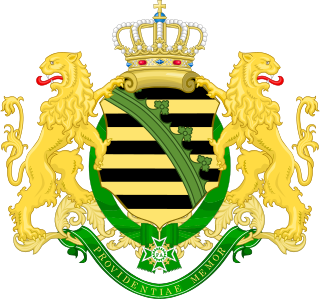
The Royal Saxon Army was the military force of the Electorate (1682–1807) and later the Kingdom of Saxony (1807–1918). A regular Saxon army was first established in 1682 and it continued to exist until the abolition of the German monarchies in 1918. With the formation of the Confederation of the Rhine by Napoleon the Royal Saxon Army joined the French "Grande Armée" along with 37 other German states.

In the Battle of Alba de Tormes on 28 November 1809, an Imperial French corps commanded by François Étienne de Kellermann attacked a Spanish army led by Diego de Cañas y Portocarrero, Duke del Parque. Finding the Spanish army in the midst of crossing the Tormes River, Kellermann did not wait for his infantry under Jean Gabriel Marchand to arrive, but led the French cavalry in a series of charges that routed the Spanish units on the near bank with heavy losses. Del Parque's army was forced to take refuge in the mountains that winter. Alba de Tormes is 21 kilometres (13 mi) southeast of Salamanca, Spain. The action occurred during the Peninsular War, part of the Napoleonic Wars.

The North Somerset Yeomanry was a part-time cavalry regiment of the British Army from 1798 to 1967. It maintained order in Somerset in the days before organised police forces, and supplied volunteers to fight in the Second Boer War. It served on the Western Front in the First World War. At the outbreak of the Second World War, it continued to operate in the mounted role and then as a specialist signals unit. Postwar it joined the Royal Armoured Corps and later became infantry. Its lineage today is maintained by 93 Squadron 39 (Skinners) Signal Regiment.

The Queen's Own Yorkshire Dragoons was a yeomanry regiment of the British Army in existence from 1794 to 1956. It was formed as a volunteer cavalry force in 1794 during the French Revolutionary Wars. Its volunteer companies played an active role with the Imperial Yeomanry in the Second Boer War, but opportunities for mounted action were much more restricted during the First World War and it was temporarily converted into a cycle unit. It remained a cavalry regiment throughout the interwar years, and was the last horsed unit of the British Army to see action, in the Syria–Lebanon Campaign of 1941, finally mechanising the following year. It served as motorised infantry in the North African and Italian campaigns of the Second World War. In 1956, it merged with the Yorkshire Hussars and the East Riding of Yorkshire Yeomanry to form the Queen's Own Yorkshire Yeomanry. Its lineage is continued today by A Squadron, the Queen's Own Yeomanry.
The types of military forces in the Napoleonic Wars represented the unique tactical use of distinct military units, or their origin within different European regions. By and large the military forces during the period had not changed significantly from those of the 18th century, although their employment would differ significantly.
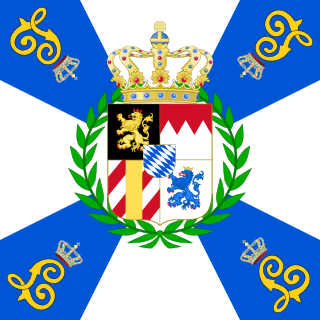
The Bavarian Army was the army of the Electorate (1682–1806) and then Kingdom (1806–1918) of Bavaria. It existed from 1682 as the standing army of Bavaria until the merger of the military sovereignty of Bavaria into that of the German State in 1919. The Bavarian Army was never comparable to the armies of the Great Powers of the 19th century, but it did provide the Wittelsbach dynasty with sufficient scope of action, in the context of effective alliance politics, to transform Bavaria from a territorially-disjointed small state to the second-largest state of the German Empire after Prussia.
The history of the German Cavalry in World War I is one of an arm in decline.
References
- ↑ The Line Cavalry Regiments at www.1914-1918.net. Retrieved 22 Aug 2017.
- ↑ Clodfelter, Micheal. Warfare and Armed Conflicts: A Statistical Encyclopaedia of Casualty and Other Figures, 1492-2015, 4th edn., Jefferson: McFarland, 2017. p. 144.